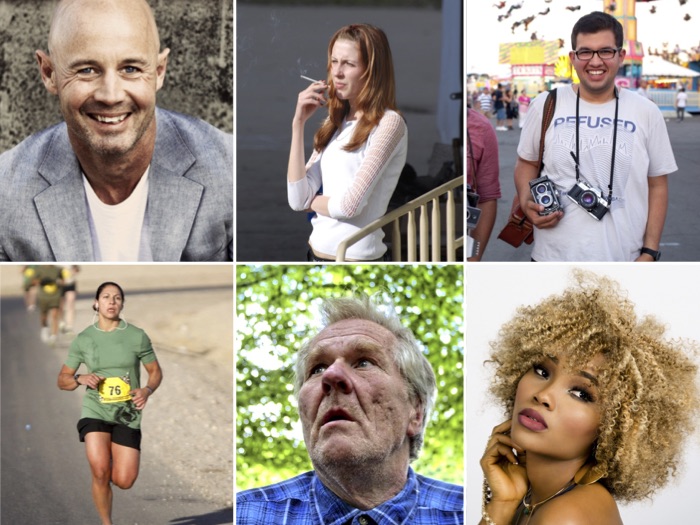The entertainment and advertisement industries depend on us all having the same instant idea of what someone is like based only on how they look.
The problem is that we carry this over into our daily life and typecast the people we see around us within a fraction of a second. And then we discover that 99% of the time it’s a total MISMATCH with what they’re really like.
Ever been on a first date? Ever met a “hot mess”? Ever felt misunderstood and realized people are typecasting you incorrectly?
Grab a friend and call out what you think the people in the photos are like the instant you see each one. Notice how different your reactions can be!
What are we noticing?
We’re noticing that no two human beings are alike.
We’re noticing how deep and rich each person actually is.
Noticing this helps us understand why our typecasts of people are ALWAYS wrong, every single time, without fail. (This is one of the few times you will hear me say something so absolutely).
Insights
No Two Human Beings Are Alike
 When I originally pulled together the remarkable list below for a speech I was giving – a list of all the facets of a human being (most of which are invisible) – I reached out to a mathematician to double-check my math because I couldn’t believe what the numbers said.
When I originally pulled together the remarkable list below for a speech I was giving – a list of all the facets of a human being (most of which are invisible) – I reached out to a mathematician to double-check my math because I couldn’t believe what the numbers said.
My list of human attributes (facets) was about 60 items long.
If we say for a moment that each of these independent human attributes was only an on or off, one or the other, binary kind of thing, then to calculate the number of combinations of human beings that are possible, this list of 60 items can be calculated as 2 to the power of 60…
260 = 1,152,921,504,606,846,976
or over 1 quintillion combinations of human beings.
But there are actually far more combinations than that because most of the attributes are spectrums, ranges, and sometimes multiple choice.
Visible Human Attributes
- Body type
- Face
- Age
- Race – Asian, Black, Caucasian, etc
- Ethnicity – Jewish, Eritrean, Japanese, hispanic, middle-eastern, etc
- Fashion – clothes, hair, makeup, bling
- Mannerisms – masculine, feminine, animated, reserved
- Fitness – from couch potato to fit physique
- Sex – physical appearance is male, female, or in-between
- Voice
- Physical injuries, disabilities
Invisible Human Attributes
- Sexual orientation – same-sex, opposite sex, both
- Genetalia – male, female, blend of the two
- Gender Identity – Identify as a man, woman, or a combination
- Sexual experiences – each person has a different set of them
- Sexual Activity level – from once a year to once a day, includes sex with self
- Fetishes – this list usually gets longer over time, and is very unique to each person
- Sexual styles – traditional, wild, rough, slow, intense, spiritual
- Emotion – from very sensitive to seemingly dead inside
- Empathy – the ability to connect with other people’s experiences
- Shame – how much is imposed on us and how we deal with it
- Negative experiences – any traumas that impact one’s life
- Fears
- Addictions
- Optimistic to Pessimistic
- Who a life partner is to us – from best friend and soul mate to…
- Love – the many people we love deeply and would do anything for them
- Diet – from junk food to veganism
- Exercise – from sedentary to gym junkie, hiker, walker, runner, etc
- Play – what we do for fun
- Sleep and Rest – getting enough sleep has a big affect on our lives
- Habits – daily habits and our routine
- Self-improvement – from stuck in our ways to always learning something new
- Rhythm of life – harmonious, discordant, inconsistent, repetitive
- Tidy to messy
- Ambitions
- Creativity
- Talents – art, music, speaking, juggling, comedy, teaching, crafts, cooking, etc
- Experience – comes with age, hopefully
- Wisdom – comes with age or from study
- Clear Thinking Skills – We’re improving them now!
- Strongly Held Beliefs
- Limiting Beliefs – things that hold us back and stop us
- Integrity
- Discipline
- Languages – other languages we may be able to speak
- Communication Skills
- Achievements
- Quirks and eccentricities
- Self-expression – from bookworm to skydiver
- Introvert to extrovert
- Lonely to gregarious
- Culture – Mexican, Jewish, Italian, Chinese, etc
- Parents – both mom and dad, just a mom, just a dad, neither
- Siblings – only child, only brothers, only sisters, both brothers and sisters
- Ecomonic status from childhood to current
- Neighborhood from childhood to current – rough, scary, pleasant, posh
- Religion
- Extended family – from small to large
- Mentors and Idols – the people who’ve had a big influence on our lives
- Education – public or private, college, easy/rough/difficult schools
- Job history – from entry level jobs to careers
- Books and Movies
- Social Media
- Physical Illness – from minor chronic problems to life-threatening
- Mental Illness – from minor neuroses to being bipolar, schizophrenic, etc
- Comfort zone – how often we will leave our comfort zone
- Friends – the people who know us and we can turn to and count on
We Rarely See Ourselves From The Outside
We all know what it’s like to see ourselves on video. Most of us think it’s weird and we dislike it.
But stop and think about the fact that everyone else ONLY sees us “on video.”
Of course, they have no idea what it’s like to be us on the inside. Their typecasting of us is probably way off the mark.
What can we do right now?
Catch ourselves typecasting people and notice how super quick the typecasting can happen.
Keep in mind how different and rich everyone else is inside. Hopefully this will help us to stop thinking of other people in an oversimplified way.
ClearThinkingCampaign.org
© 2022 Mark Halvorson. All Rights Reserved.
This campaign and website imagined, created and maintained by Mark Halvorson. This is a living document. All media is properly licensed, attributed, and usage rights are respected.
Get out there and practice, practice, practice thinking clearly with your friends and family. Help refine what people say rather than reject it. Try to say what you want in the form of a question. You can also send people here and not say a word. The huge benefit from all this is that it won’t be long until people and the world won’t be able to mess with you anymore. People will notice that about you and will want to know how you did it. Be strong and have your own ideas, style and identity. We’re all in this together.
